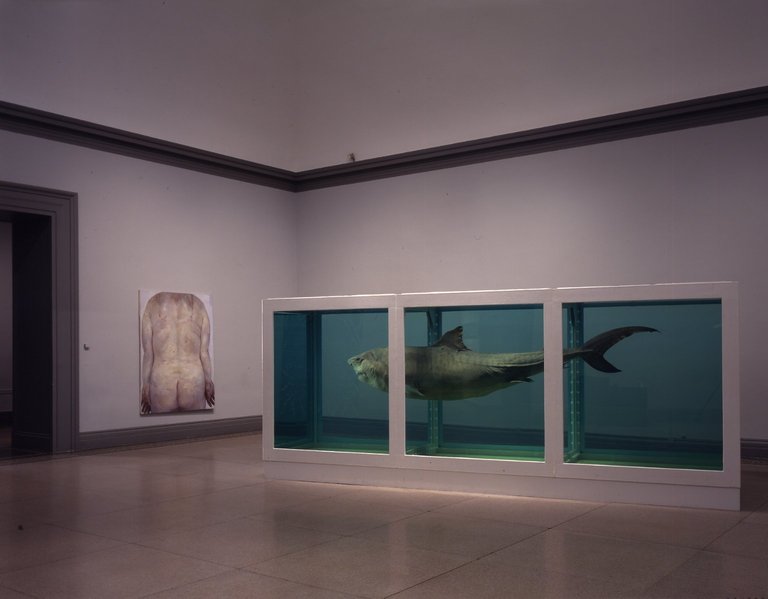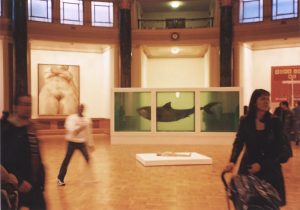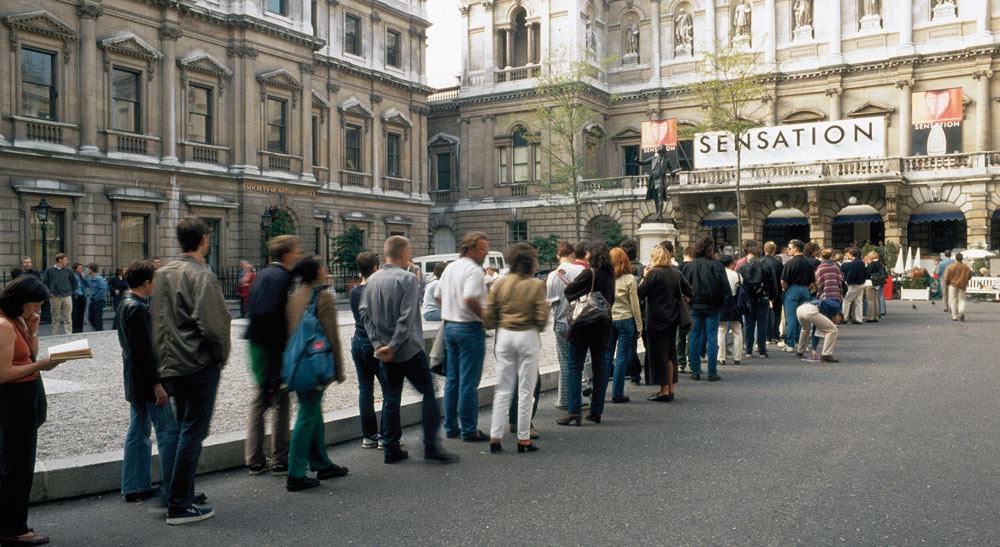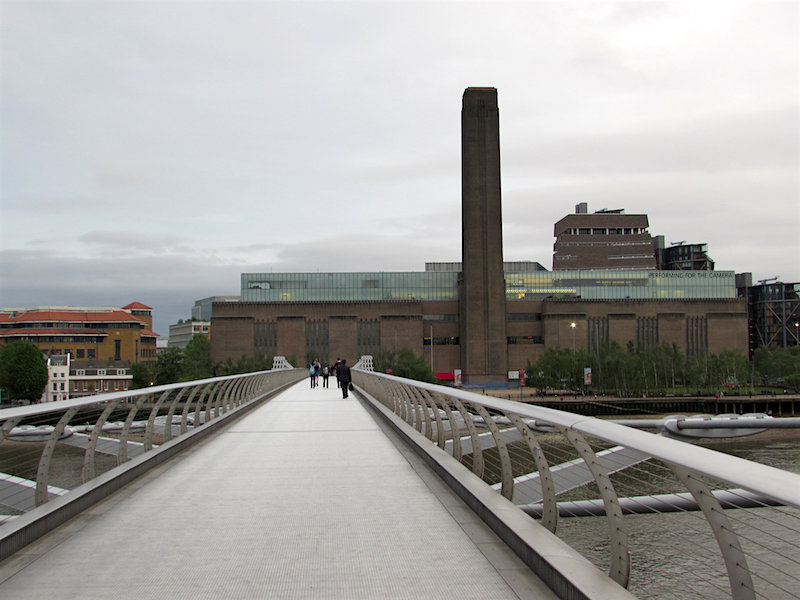“Young British Artists” (or YBAs as they swiftly became known) is now something of a misnomer. For this group of artists can no longer be described as young—they are mostly now in their fifties—and they are very international, and barely share a common style. Yet this small group of London-based artists, who came to prominence in the nineties, changed the international art world. The YBA phenomenon directly contributed to the climate of acceptance of modern and contemporary art in the U.K. which enabled the success of Tate Modern when it opened in 2000. The YBA remain a powerful force in the international art world today.
I first encountered the Young British Artists as a freelance journalist covering the arts for the mainstream press in the late nineties. By then art was no longer confined to single column reviews in remote arts pages, as it had been for decades. Instead, contemporary art was splashed over front and features pages. The Tate’s annual Turner Prize for contemporary art had become headline news, with the award ceremony broadcast live on television, and for an intoxicating time, London was the center of the international creative world—all thanks largely to the YBAs.
So who and what are the YBAs?
The YBAs were a loose and disparate group, very much associated with London in the 1990s and the period of increased pride in popular British culture dubbed “Cool Britannia.” YBA artists included Jake and Dinos Chapman, Tracey Emin, Damien Hirst, Gary Hume, Sarah Lucas, Chris Ofili, Marc Quinn, Sam Taylor-Johnson, Mark Wallinger, and Rachel Whiteread. Many of the artists had studied together at Goldsmiths College of Art in London, which had abolished the traditional separation between art forms (painting, sculpture, photography, printmaking) and focused on conceptual art, however there is no one single YBA style or approach. The work can be shocking, conceptual, or even traditional in its formal features: the principal link between the YBAs was social and attitudinal.
The majority of the artists came from non-establishment backgrounds, had grown up with Margaret Thatcher as prime minister and, perhaps as a result, had acquired an entrepreneurial, “can-do” approach to art and life. Then in their twenties and thirties, these artists were often glamorous and generally loved to party, and the nineties art world—and “Cool Britannia”—was happy to give them free rein.
Damien Hirst, Freeze, and Charles Saatchi
So how did the YBAs come into being? Damien Hirst was de facto ringleader of the YBAs. In 1988, while studying at Goldsmiths College, Hirst curated and promoted a “pop up” exhibition in an empty warehouse of work by him and his peers, entitled Freeze. Charles Saatchi, an advertising titan and art collector, bought work from Hirst’s Freeze show and from the fledging artists’ representatives. In 1992, the phrase “Young British Artists” was first used by Art Forum magazine to describe the group, and when Saatchi exhibited their work at his 30,000 square foot space in a converted paint factory in North London that same year, he entitled the show Young British Artists. And so a new movement was born. The work was new, fresh, and exciting: immediately accessible to the public, yet also with high art resonances and references.
The most expensive fish without chips

Damien Hirst, The Physical Impossibility of Death in the Mind of Someone Living, 1991, glass, painted steel, silicone, monofilament, shark and formaldehyde solution (private collection) at Sensation: Young British Artists from the Saatchi Collection, the Brooklyn Museum, October 2nd, 1999–January 9th, 2000

Damien Hirst, The Physical Impossibility of Death in the Mind of Someone Living at the Saatchi Gallery, 1991
Damien Hirst’s The Physical Impossibility of Death in the Mind of Someone Living of 1991, a shark suspended and preserved in a tank of formaldehyde, looked sensational in the Saatchi Gallery’s warehouse-style setting in the 1992 Young British Artists exhibition. The Sun tabloid newspaper ran a story about the piece entitled “£50,000 for fish without chips?” and “the shark” became an icon of nineties art and culture. As a result, Hirst was shortlisted for that year’s Turner Prize, and in 1995 was awarded the prize, which was presented to him by Charles Saatchi. The YBA star was firmly in the ascendant.
Hirst’s Turner Prize exhibition included Mother and Child Divided (1993), a cow and calf cut in half and preserved in a vitrine of formaldehyde. The work caused outrage among the animal-loving British public. Hirst commented, “I remember what Warhol said: you don’t read your reviews, you weigh them.” He might well have added another of Warhol’s aphorisms: “Making money is art. And working is art. And good business is the best art.”
YBAs at the heart of the establishment

Sensation: Young British Artists from the Saatchi Gallery at the Royal Academy, London
It was Charles Saatchi again, master of both presentation and media coverage, who positioned the YBAs firmly in the mainstream of popular culture with the 1997 exhibition Sensation, which filled the Royal Academy in London with 110 works by 42 artists from Saatchi’s personal collection. It was the year that Princess Diana died and Tony Blair became Prime Minister. The country was ripe for a change. The YBA’s column inches became column miles: the exhibition was visited by 285,000 people, almost half of them aged under thirty. A new audience and climate had been created for modern art. Contemporary art was now at the fore of public consciousness.
The path to Tate Modern
Until Tate Modern opened in 2000, London was the only major European city without a public art gallery for modern and contemporary art. Britain was resolutely philistine about the visual as epitomized by a controversy in 1976 triggered by the display of Carl Andre’s Equivalent VIII (1966) as a recent acquisition at the Tate Gallery in Millbank (now Tate Britain). The Evening Standard referred to the sculpture as a “pile of bricks.” Public outrage and protest focused on the expenditure of “tax payers’ money” on this Minimalist work made of manufactured bricks. Evidently, much needed to change before a museum of modern art would be welcome in London. Private funds would be required in order for public collections to acquire modern and contemporary art, and ultimately to support a London museum dedicated to its display.
In 1984 the Tate’s annual Turner Prize for new art was founded with the long-term goal of creating an open and understanding climate for modern and contemporary art. By the mid-nineties, thanks to the nominated Young British Artists’ high profile and pulling power, the Turner Prize had become a major annual event, with record-breaking numbers of visitors to the Tate’s exhibition of short-listed artists, and its gala dinners and prize-giving ceremonies avidly attended and covered, with the likes of Madonna presenting the prize. The purpose of the Turner Prize was accomplished, thanks in great part to the YBAs, and the public made ready for the opening of Tate Modern.
“Art is power”

Tate Modern from the Millennium Bridge, photo: Michael Day (CC BY-NC 2.0)
When Tate Modern (a museum dedicated to modern and contemporary art) opened in London in May 2000, its launch party for 4,000 people was the hottest ticket in town, and broadcast live on the BBC. Invitations were said to be changing hands for up to £1,000 and some left town rather than admit they were not on the list. “Everyone” was there, yet it was the Young British Artists who had done so much with their talent, energy and glamour to bring the art world’s focus to London for the first time in centuries (and to create a climate of acceptance for contemporary art), who provided the stardust. The YBAs ensured that Tate Modern’s opening party was the place to be and the museum was an instant success, with visitor numbers vastly higher than anticipated.
As the artistic duo Gilbert & George said as they opened the building earlier that day in front of the Queen of England, “Art is power.” The YBAs ruled the establishment: the artists were celebrities and everyone wanted to know more about them. And that, for a while, was how I made my living. Then it all suddenly came to an end, with 9/11 as a marker. Shortly after the twin tower attacks, Charles Saatchi closed the private gallery that had done so much to incubate the YBA movement, and there was a sense of moving on. I went into teaching and now teach the work of many of the artists I interviewed. The young adults I teach are consistently fascinated by the YBAs’ work, which speaks very strongly to them, and convinces me that even now—long after the parties and the scene have faded—the work itself will endure and stand the test of time.
Additional resources:
Tate on the Young British Artists
Damien Hirst: Art and Life (video)
The Saatchi Gallery on Sensation at the Royal Academy
Tate archive on Carl Andre’s Equivalent VIII and the “Bricks controversy”
Tate archive on the opening of Tate Modern
Rose Aidin, “The Comeback King,” The Saturday Telegraph Magazine (October 2, 2001)
Rose Aidin, “Brit Art’s square dealer moves on,” The Guardian (September 22, 2002)
“Tate Gallery Buys Pile of Bricks—Or Is It Art?,” The New York Times (February 20, 1976)


